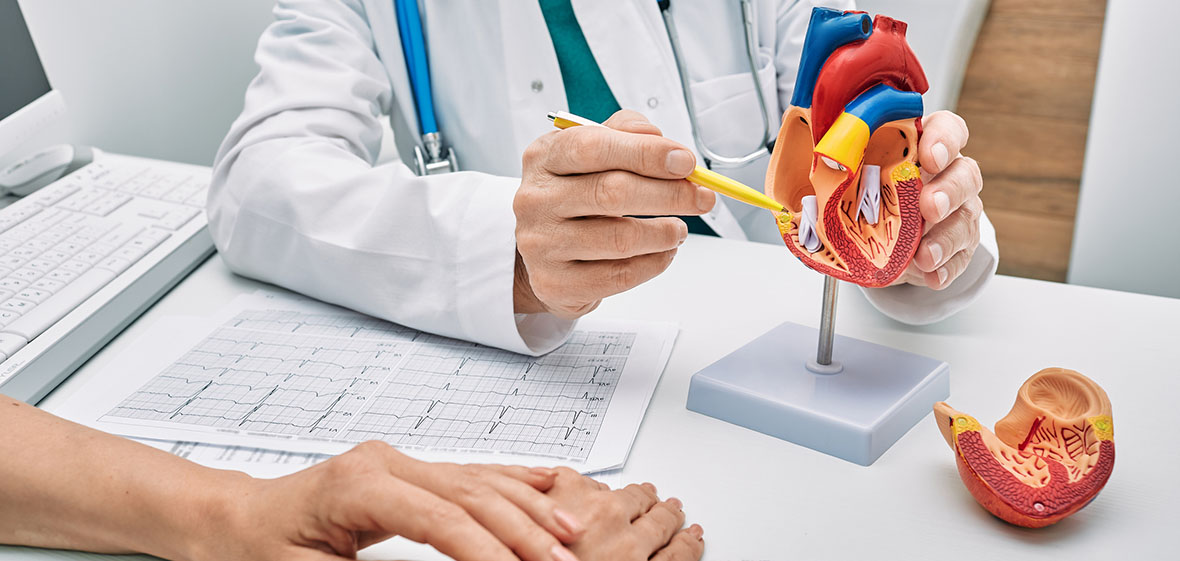
The Procedure
Cardiac catheterization is a procedure used to diagnose and treat heart conditions. It involves inserting a thin, flexible tube (catheter) into a blood vessel, often through the groin or wrist, and threading it to the coronary arteries of the heart.
Contrast dye is injected into the coronary arteries through the catheter making them visible on X-ray images. This helps cardiologists assess blood flow and identify blockages or narrowings.
In cases where blockages are identified, procedures like angioplasty may be performed to open narrowed arteries, and stents can be placed to keep them open. The catheter can also measure blood pressure within the heart’s chambers, providing valuable data on cardiac function.
The procedure also can be used to take samples of your heart muscle for diagnosis of the cause of your heart’s dysfunction. Additionally, cardiac catheterization is a minimally-invasive option to repair heart defects and replace heart valves.
After the Procedure
After the procedure, you’ll be moved to a recovery room where you’ll lie flat for two to six hours if the catheterization was done via the groin. If the catheterization was performed from the wrist or from the neck, you will be observed in the recovery area but can sit up.
Meanwhile, a nurse will monitor your heart rate and blood pressure, as well as any signs of chest pain and swelling, pain or bleeding at the puncture site. Patients are encouraged to stay hydrated.
If you have a stent placed in a coronary artery, you will be admitted to the hospital, typically for one night for observation. If not, you will likely be discharged home the same day. It is strongly advised you have a friend or family member drive you home if a sedative has been used.
Before you leave the hospital, you’ll be given written instructions about how to continue your care at home. It’s important that you follow these instructions carefully, including taking any medications that you may be prescribed.
Recovery and Home Care Instructions
Post-cardiac catheterization care involves several key aspects to ensure a smooth recovery and long-term heart health:
- Catheter Insertion Site Care: After a cardiac catheterization, you can remove the dressing covering the catheter insertion site the day after the procedure. It’s preferable to do this while showering. Some bruising, swelling and the presence of a small lump at the site are normal. After removing the dressing, apply a small adhesive bandage. Maintain cleanliness by gently washing the site daily with soapy water, being cautious not to rub the area. Avoid using creams, lotions or ointments on the wound. Wearing loose clothing can help minimize friction at the site. Additionally, for a week following the procedure, avoid activities like soaking in a bathtub or hot tub and swimming in pools or lakes.
- Activity Guidelines (Groin/Femoral Cardiac Catheterization):
- Avoid straining during bowel movements for the first three to four days to prevent bleeding from the catheter insertion site.
- Heavy lifting (more than 10 pounds) and strenuous activities, including most sports such as jogging, golf, tennis and bowling, should be avoided for five to seven days.
- While you may climb stairs if necessary, do so more slowly than usual.
- Gradually increase your activities over the course of a week until you reach your normal activity level.
- Activity Guidelines (Wrist/Radial Cardiac Catheterization):
- Avoid strenuous activities for two days after the procedure, including most sports.
- In most cases, you can resume driving within 24 hours after returning home.
- Gradually increase your activities over two days until you reach your normal activity level.
- Consult your doctor to determine when it’s safe to return to work, resume sexual activity and resume driving.
- Medications: Strict adherence to your prescribed medication regimen is paramount, especially the prescribed regimen of blood thinners and diabetes medications.
- Fluid Guidelines: Maintaining proper hydration is essential. Drinking eight to ten glasses of clear fluids, with a preference for water, helps flush the contrast material used during the procedure from your system.
- Heart-Healthy Lifestyle: Commit to a heart-healthy lifestyle by adhering to medication schedules, making dietary changes, quitting smoking, exercising regularly, attending follow-up appointments and actively participating in your treatment plan.
When to Call the Doctor
After a cardiac catheterization procedure, it’s important to monitor your health for potential complications and to contact your health care provider if you experience any of the following symptoms, as they could indicate serious issues:
- Uncontrolled bleeding from the access site despite firm pressure.
- New or worsening chest pain, which might suggest heart problems or a heart attack.
- Dizziness, which could be a sign of changes in blood pressure or circulation.
- Fever, potentially indicating an infection.
- Irregular, very slow or fast heartbeat, especially if accompanied by chest discomfort.
- Swelling at the access site, which might point to a hematoma or other concerns.
- Yellow or green discharge draining from the access site, which may indicate infection.
- Numbness, weakness or color changes in the arm or leg used for access, suggesting a possible compromise in blood flow.
UofL Health provides some of the best heart doctors in the region as part of UofL Health – Heart Hospital. To learn more about our interventional cardiology services, click here.









